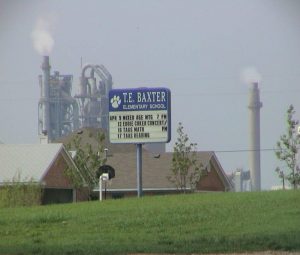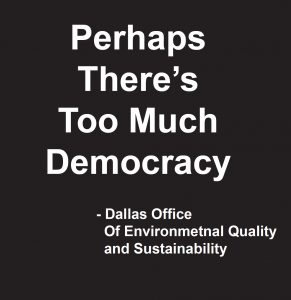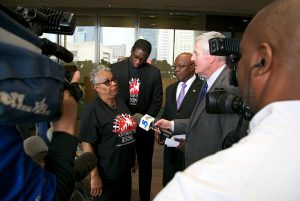Particulate Matter
COVID CONNECTIONS
Downwinders At Risk was already dedicated to fighting for environmental health in North Texas before the COVID virus hit.
Focusing on harmful Particulate Matter, we were already supporting grassroots efforts to reduce the air pollution burdens in predominantly Black and Brown neighborhoods.
We were already building out local capacity to monitor DFW air pollution and advocating an increased role for local cities and counties to protect their residents from environmental health threats.
All of that work was important before March. It’s become more important since then. But our responsibilities on the ground are outstripping our ability to support them adequately. Like other non-profits, the virus has made it harder to do even the simple things.
This week you can help provide some relief.
The Peace Development Fund has chosen to spotlight the COVID-connected work Downwinders is doing, along with that of 12 other grassroots groups across the country to help supplement their budgets during the crisis. The Fund and generous donors are matching every dollar we raise this week up to $10,000 – that’s a $20,00,000 grant on the line.
We have until Friday to raise the $10,000.
Beginning today and continuing thru Tuesday the 5th at Midnight you can help us meet this goal by contributing via our North Texas Giving Day Page.
Then Wednesday thru Friday the Development Fund has its own Downwinders Mighty Cause pay portal you can also use.
We’re using each day this week to show how our various pieces of program work is more relevant than ever before. Today it’s an update on our ambitious new DFW air monitoring network – SHAREDAIRSDFW.
We know everyone is having a hard time, but with the Development Fund matching your dollars, you can make whatever contribution you give go twice as far to benefit those at highest risk.
Thanks for your support,


Evelyn Mayo, Chair
COVID Connects:
Vulnerable Communities to the Need
for Better Air Pollution Monitoring
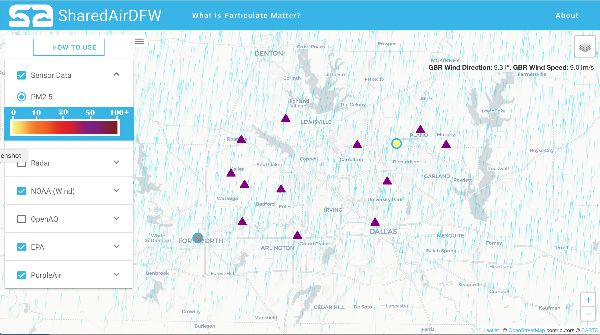
A screenshot of the SHAREDAIRDFW network map being assembled by UTD students and Downwinders at Risk. This map will soon be available at websites hosted by UTD, Dallas County and Downwinders, Only two of the over 100 new monitors are installed (dots) but more are on their way.
What is It?
The SHAREDAIRDFW community air quality monitoring network. 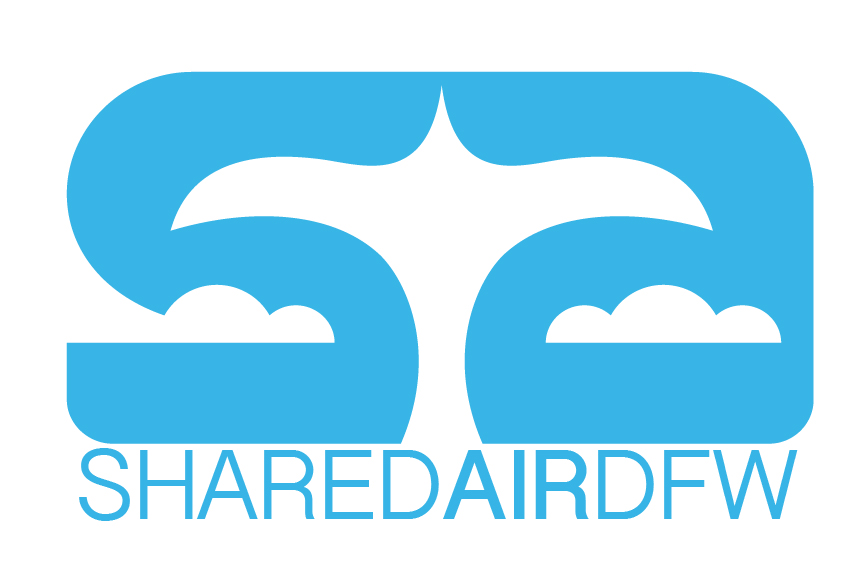 With its partners at UTD, Downwinders is building a new air monitoring network for DFW that will provide real time information from over 100 locations, including industrial hot spots in Joppa, West Dallas and Midlothian.
With its partners at UTD, Downwinders is building a new air monitoring network for DFW that will provide real time information from over 100 locations, including industrial hot spots in Joppa, West Dallas and Midlothian.
Why Do It?
Dallas County’s 2.7 million residents currently share only one EPA 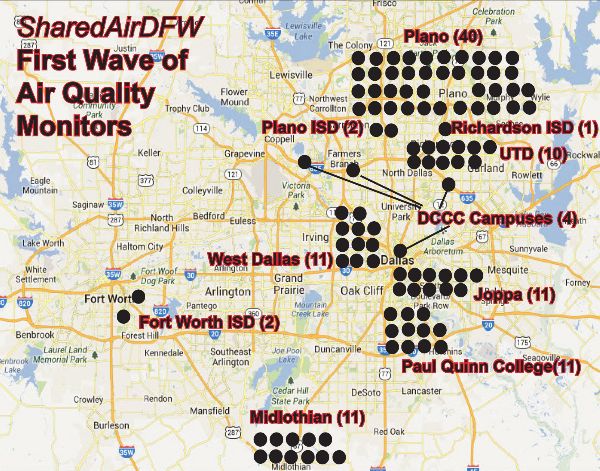 Particulate Matter air pollution monitor, north of downtown. Tarrant County has two and Denton County one. These monitors only reflect very local conditions and don’t reveal pollution levels in “frontline” neighborhoods where industry operates next to homes.
Particulate Matter air pollution monitor, north of downtown. Tarrant County has two and Denton County one. These monitors only reflect very local conditions and don’t reveal pollution levels in “frontline” neighborhoods where industry operates next to homes.
Making pollution burdens more equitable across racial and class lines requires identifying, measuring, and mapping those burdens: “You can’t fix what you don’t measure.” The SHAREDAIRDFW network is the first attempt to permanently map air pollution burdens across North Texas and make that information easily accessible to the public 24/7.Dallas County’s 2.7 million residents currently share only one EPA Particulate Matter air pollution monitor, north of downtown. Tarrant County has two and Denton County one. These monitors only reflect very local conditions and don’t reveal pollution levels in “frontline” neighborhoods where industry operates next to homes.
Making pollution burdens more equitable across racial and class lines requires identifying, measuring, and mapping those burdens: “You can’t fix what you don’t measure.” The SHAREDAIRDFW network is the first attempt to permanently map air pollution burdens across North Texas and make that information easily accessible to the public 24/7.
What’s the COVID Connection?
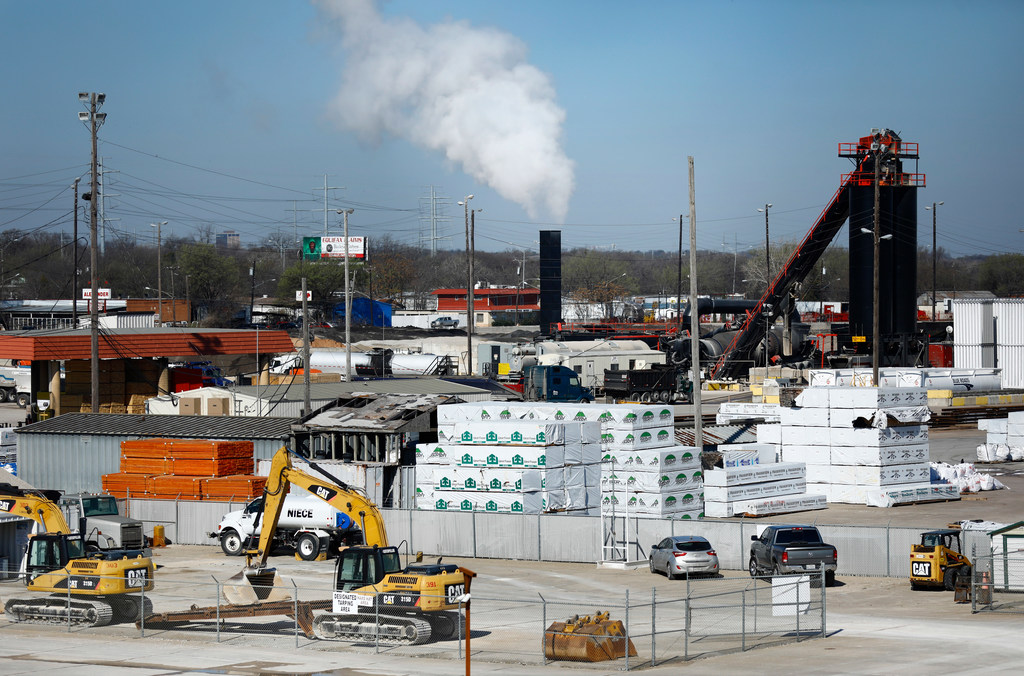
Research being done during the COVID pandemic concludes those living with the highest air pollution burdens are among the most vulnerable to being infected and dying from it. Specifically there seems to be a connection between a person’s exposure to Particulate Matter and Nitrogen Oxide air pollutants and the likelihood of contracting COVID. Past studies from the SARS epidemic also point to a strong link between exposure to air pollution and vulnerability to illness.By mapping where the heaviest air pollution burdens are, we can avoid adding to that burden and pursue policies targeting pollution decreases. We can begin to reverse the circumstances that makes the most pollution-impacted neighborhoods the most vulnerable to disease.
STATUS?
Via teleconferencing, UTD students are finishing up the digital map the Network 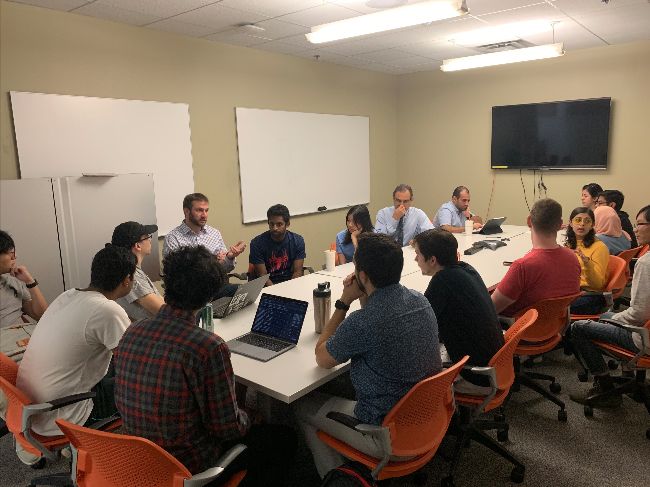 will use to display its real time air quality information. This map is meant to display not only the levels recorded by our own fleet of monitors, but easy access to the handful of EPA and Purple Air monitors in DFW as well.
will use to display its real time air quality information. This map is meant to display not only the levels recorded by our own fleet of monitors, but easy access to the handful of EPA and Purple Air monitors in DFW as well.
The map will be hosted on websites hosted by UTD, Dallas County and Downwinders.The first community monitors are slated for the former Freedman’s town of Joppa, where Downwinders bought a utility pole for the installation of the larger Mothership monitor. We’ve got a contract for Internet service and are now trying to tie down electrical power.
After a planned community meeting in March was canceled, we’re now gearing back up to find hosts for all ten “satellite” monitors. We hope to be able to begin operat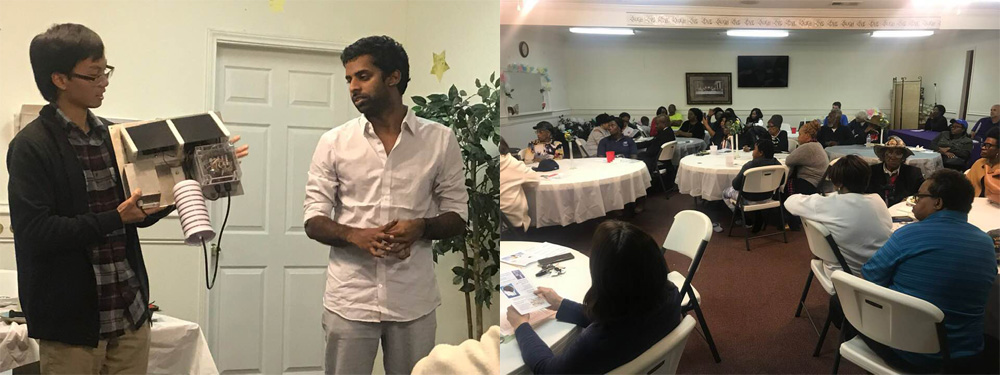 ion this summer.Once we’re up and running in Joppa, West Dallas is next and then Midlothian. In all Downwiwnders will be responsible for 33 of the over 100
ion this summer.Once we’re up and running in Joppa, West Dallas is next and then Midlothian. In all Downwiwnders will be responsible for 33 of the over 100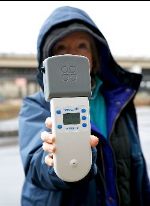 network monitors going up as part of the first wave installation.
network monitors going up as part of the first wave installation.
……MEANWHILE, Downwinders is using its portable monitors to record air quality in front line neighborhoods during the shelter-in-place periods so we’ll have a baseline for what cleaner air looks like.
First Regional Air Monitoring Network “Meet and Greet” in Joppa Draws Packed House and Volunteers
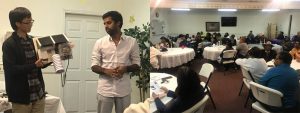
A new regional air quality network bringing 21st Century science to some of Dallas’ most polluted neighborhoods had it’s official coming out party on December 5th in the former Freedman’s community of Joppa.
A community meeting at New Zion Missionary Baptist Church sponsored by Downwinders at Risk in association with Paul Quinn College and Habitat for Humanity drew a standing room only crowd.
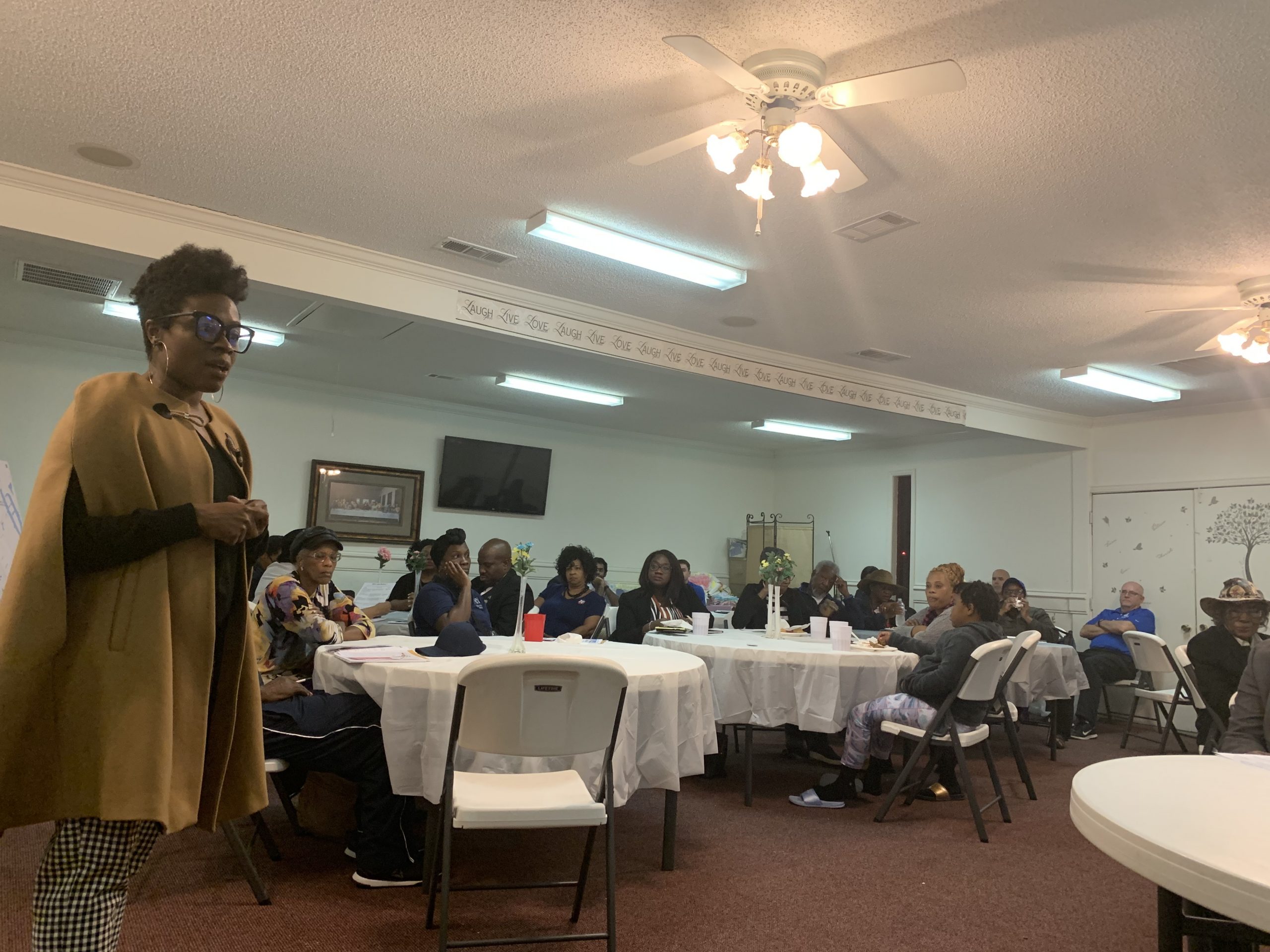 Food from Jason’s, door prizes, and the opportunity for a Parkland Hospital health screening made the meeting into a real community event.
Food from Jason’s, door prizes, and the opportunity for a Parkland Hospital health screening made the meeting into a real community event.
Residents got to see a monitor up close and hear a presentation by the University of Texas at Dallas graduate students building them for distribution over the next year. 11 of the monitors are due to be installed in Joppa, with another 11 installed in near-by Southern Dallas neighborhoods by Paul Quinn College. In total, over 100 are scheduled to be distributed from Plano to Fort Worth to Midlothian in the largest non-government network of its kind in Texas.
Joppa is surrounded by multiple sources of Particulate Matter air pollution, including a concrete batch plant, an asphalt batch plant, a Union Pacific railroad switch yard, Loop 12 and the Tamko asphalt shingle factory. Because of its compact size an relatively small population, it has the highest per capita air pollution burden in Dallas.
That’s why Downwinders chose to begin building its part of the network in Joppa. Thursday’s roll out was the first attempt to find hosts for the monitors among the neighborhood’s residents.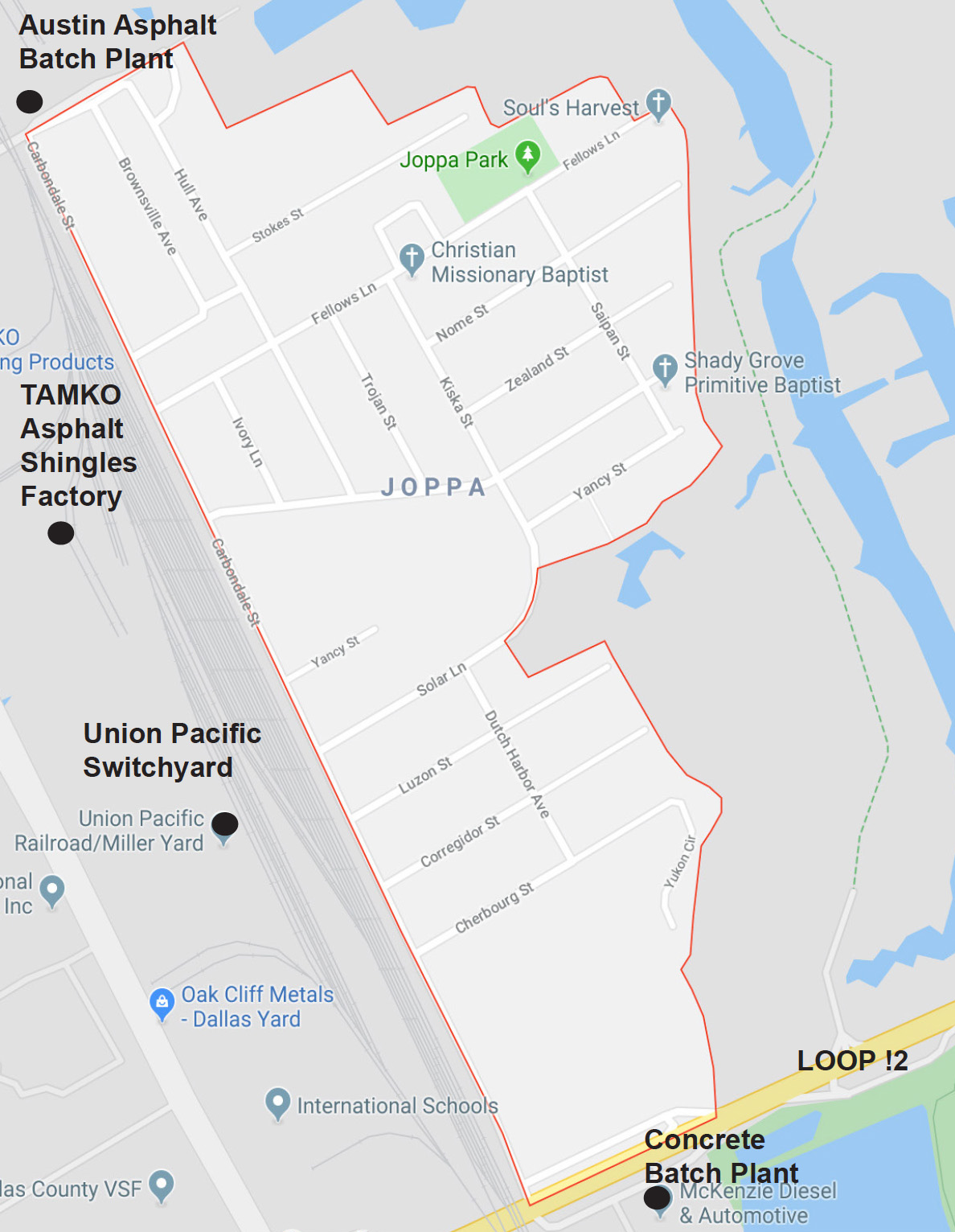
There were lots of questions and lots of enthusiasm. At least two Joppa residents didn’t need any more convincing and wanted to know how fast they could get a monitor at their house.
The answer is….soon. District 7 Council Member Adam Bazaldua is assisting the network in coordinating the electrical and internet connections we need for the “mothership” that carries the load for 10 smaller solar-powered and wireless sensors. A utility pole Downwinders bought from Oncor for that very purpose is only about 30 feet down the street road the New Zion Church where the meeting was taking place. All we need now are the connections.
Downwinders will be following up this meeting with door-to-door canvassing in Joppa and updates to everyone who signed-in. Meanwhile, we should be scheduling similar meetings in West Dallas and Midlothian after the first of the year.
After years of planning and preparation, we’re finally beginning to see the payoff of our vision. Thanks to all of our supporters for helping us achieve this first, but important milestone
Update: A 21st Century Regional Air Monitoring Network for DFW is On Its Way
 me technical and bureaucratic hitches, momentum is starting to build toward the 2020 operation of a true 21st Century DFW regional air quality monitoring network.
me technical and bureaucratic hitches, momentum is starting to build toward the 2020 operation of a true 21st Century DFW regional air quality monitoring network.
A small army of University of Texas at Dallas graduate students are assembling over 100 solar-powered wireless air monitoring units to be dispersed throughout the metro area. A third of those have been purchased by Downwinders for placement in Joppa, West Dallas, and Midlothian. 40 or more or going to Plano. Three Dallas County Community College campuses are receiving one, along with the Fort Worth and Richardson school districts.
And now news has come that Paul Quinn College has received an EPA grant to purchase 11 of these monitors for placement around its Southern Dallas campus. Downwinders is working to coordinate the location of its Joppa area monitors with Paul Quinn to provide Southern Dallas with its own mini-network of monitors.
Meanwhile another group of UTD students are working on the mapping software and app residents will be able to use to access the data in real time. They’re being led in this effort by Robert “The Map” Mundinger, who Downwinders hired for the job. All in all, Downwinders has now invested almost $50,000 in this network, which we hope will become a model for the rest of Texas and the nation.
LafargeHolcim is a “Conscientious Corporate Citizen” Everywhere But Texas

In Europe, LafargeHolcim is a multinational cement manufacturer based in Switzerland and France – two countries on the cutting edge of climate crisis planning and members of the progressive European Union. The Company portrays itself as a climate-conscientious corporate citizen, to the point of its Swiss CEO declaring the reduction of CO2 emissions as his first, most important priority.
In Midlothian Texas, LafargeHolcim runs the most conventionally dirty cement plant in Texas and is seeking a permit that could make it one of the most climate-hostile one as well. In fact, there’s some reason to believe the Holcim plant in North Texas is preparing to burn by-products from either the Canadian Tar Sands, the Permian Oil Field, or both, as fuel.
Baking rock to make cement takes a lot of heat. Regardless of how new or old a cement kiln is, regardless of the pollution controls a kiln has, every cement maker in the world still has to employ the same age-old process of applying a 2000 degree open flame to a mix of limestone and other ingredients. A third or more of the cost of running a cement plant is keeping that open flame consistently hot enough to do the job.
This is the reason cement kilns will always try to find cheap, free, even profitable sources of fuel for that flame. Hazardous and industrial wastes that c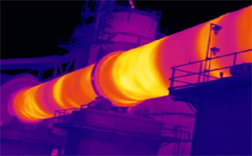 an be diverted from incinerators or landfills can be burned in cement kilns for slightly less money because they don’t have to meet the same standards. Used tires and oil. Lottery tickets. Dashboards from cars. Even municipal waste is now being burned in kilns.
an be diverted from incinerators or landfills can be burned in cement kilns for slightly less money because they don’t have to meet the same standards. Used tires and oil. Lottery tickets. Dashboards from cars. Even municipal waste is now being burned in kilns.
Burning anything causes air pollution. Burning wastes causes lots of conventional and exotic air pollution, including CO2. But just baking limestone rock also releases a lot of stored CO2. Even if there was some was to make cement without a flame, the heat needed would still release tons of CO2.
Worldwide the cement industry is estimated to be responsible for 5 to 7% of the planet’s CO2 emissions – larger then the airline industry. If the industry were a country, it would be the third largest emitter on earth, behind the United States and China.
Companies like LafargeHolcim are facing both public and financial pressures to reduce that number. In July European funds managing $2 trillion in assets called on cement companies to slash their greenhouse gas emissions, warning that a failure to do so could put their business models at risk. The mangers specifically mentioned LafargeHolcim and urged it to adopt the goal of net zero carbon emissions by 2050 and align itself with the Paris Climate Accords.
LaFarge Holcim has responded by initiating a series of technical innovations and pilot projects under the banner of “The Plant of Tomorrow” to prove its forward thinking.
Almost 300 facilities around the globe are targeted for inclusion in one or more of these “Plant of Tomorrow” projects, including a Canadian kiln installing a carbon-capture pilot project, an Ohio kiln building three wind turbines to secure its electrical needs, and kilns burning industrial waste as “low carbon” (if not low toxic) fuel.
Left out of this mix so far is Holcim’s woe-be-gone Midlothian plant. You might call it Holcim’s “Plant of Yesterday.” Despite having lots of stiff competition, Holcim not only operates the dirtiest cement plant out of the three doing business in Midlothian, but it’s the dirtiest in the entire state.
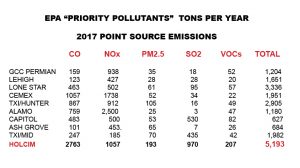
Holcim’s Midlothian plant is the largest Carbon Monoxide (CO) polluter among all 10 Texas cement plants – a sign of poor combustion. It’s the second largest Nitrogen Oxide (NOx) polluter among the bunch, emitting almost twice as much smog pollution as the other two Midlothian cement plants combined. It’s the largest PM 2.5 (Particulate Matter) polluter by far – almost 100 tons a year separate it from second place. It’s the largest Sulfur Dioxide (SO2) polluter by a large margin and releases four times as much Volatile Organic Compounds (VOCs) than the next highest plant. Almost all 2017 pollution numbers for Holcim have gone up over the last five years. A plant that was already bad is getting worse.
Now add Holcim’s request for a new permit to burn 100% Petroleum Coke in one of its two kilns.
Pet Coke is a byproduct of oil refining. It’s a concentrated carbon solid residue that is left behind after the refining process has converted the bulk of the oil into liquid fuels such as gasoline and diesel.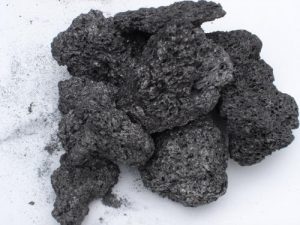
Pet Coke is like coal, but dirtier. Pet Coke looks and acts like coal, but it has even higher carbon emissions than coal. On a per-unit of energy basis Pet Coke emits 5 to 10 percent more carbon dioxide than coal. A ton of Pet Coke yields on average 53.6 percent more co2 than a ton of coal.
As well as significantly higher co2 emissions, Pet Coke also has high sulfur and toxic metals content than coal.
Because its a waste product, Pet Coke is cheap for Holcim to buy or it could even be free if a refinery wanted to get rid of its supply. And now, thanks to the exploitation of the Tar Sands and the oil boom in the Permian the US has lots and lots of Pet Coke. The heavy oil refining capacity in America is now the largest in the world, with over 40 percent of the global market. Much of that production takes place on the Texas Gulf Coast in huge new expanded refinery complexes like Motiva and Total in Port Arthur. The capacity to produce Pet Coke in U.S. refineries has doubled since 1999. In fact, the annual production of Pet Coke is so large these days, it’s outstripped most of the usual uses for it and is “priced to move.”
Because Holcim wants to burn 100% Pet Coke, and it must have a reliable source to burn it 24/7, there’s reason to believe the company has signed a sweetheart deal with one or more refineries to supply it. Probably from the Gulf Coast, and probably from one of the refineries dealing in Canadian Tar Sands oil or Permian Basin product. Both are poster boys for irresponsible fossil fuel development with the Tar Sands and the Keystone Pipeline igniting modern Climate Crisis activism and the Permian becoming one the planet’s largest sources of Methane as tons of unused natural gas are burned off from thousands of rigs.
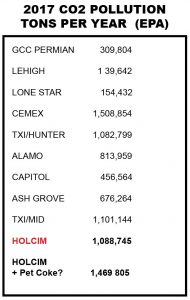 Currently, Holcim is “only” the third largest CO2 polluter among all ten cement plants in Texas, and fourth among all of Holcim’s U.S. plants. But burning 100% Pet Coke in its Kiln #2 could change that rapidly by adding a whopping 400,000 tons more of CO2 to its annual totals. That would send it to #2 in Texas and #2 in the entire US Holcim fleet of cement plants. Not very climate conscientious. And probably not a number you want to tout in trying to sell your “Plant of Tomorrow.”
Currently, Holcim is “only” the third largest CO2 polluter among all ten cement plants in Texas, and fourth among all of Holcim’s U.S. plants. But burning 100% Pet Coke in its Kiln #2 could change that rapidly by adding a whopping 400,000 tons more of CO2 to its annual totals. That would send it to #2 in Texas and #2 in the entire US Holcim fleet of cement plants. Not very climate conscientious. And probably not a number you want to tout in trying to sell your “Plant of Tomorrow.”
At the same time Holcim is trying to project an image of a concerned 21st Century corporate entity to the rest of the world, it’s doing business in Texas like its still 1999.
Officially, the State of Texas doesn’t care about CO2 pollution. Heck, officially it doesn’t even believe there’s a climate crisis. There is no regulatory system for controlling its releases and only the EPA bothers to track CO2 releases at all. So this increase in planet-melting pollution will go completely unaddressed in the permit proceedings themselves.
Also officially, despite the evidence, the State and Holcim both say no other kinds of pollution will increase when 100% Pet Coke is burned at Holcim. No increase in PM 2. 5. No increase in SO2. No increase in metals. Citizens don’t believe them. A group calling itself “Midlothian Breathes” has formed to fight the new permit and has already caught regulators off guard asking tough questions about new emissions.
But trying to get the State of Texas to do the right thing about air pollution is an uphill fight. Instead, perhaps citizens should take these embarrassing numbers directly to LafargeHolcim, who’s claims of new fund corporate responsibility are belied by them. Contrasting its Texas operations with those of the rest of its facilities may be a way to shame the company in its own European backyard. Officially the company may still be able to be embarrassed. Texas state government left that possibility behind years ago.
DFW Holcim Cement Plant Seeks to Burn 100% Petroleum Coke
Increases Predicted in Air Pollution, including 100 more tons of PM a Year
Holcim Cement’s Midlothian cement plant has requested a permit application to the Texas Commission on Environmental Quality to release an additional 2700 tons per year of Carbon Monoxide and burn 100% Petroleum Coke in its Kiln #2. Holcim estimates these change will set of federally-mandated reviews for increases in emissions of Particulate Matter (PM), Nitrogen Oxide (NOx), Sulfur Dioxide (SOx), and Carbon Monoxide (CO).
Notice of the company’s permit amendment was published in the Midlothian Mirror earlier in the  month.
month.
Holcim is one of three very large cement plants doing business just south of I-20 in Midlothian in what is the largest concentration of cement manufacturing in the U.S. The other two are TXI and Ash Grove. These are not batch plants. These are where the batch plants get their product. With annual air pollution emissions in the thousands of tons, any one of these kilns would easily be the largest “stationary” industrial source of air pollution in North Texas. Combined, they represent a mega source of air pollution for DFW.
Review of the numbers in the permit application show the company wants to scrap its current limit of a little over 4000 tons a year for Carbon Monoxide and replace it with a higher 7112 ton per year ceiling. In addition, the difference between actual emissions and proposed changes could result in 100 tons more of Particulate Matter, 260 more tons of smog-forming Nitrogen Oxide, and 1700 additional tons of Sulfur Dioxide.
 Missing from the permit analysis is the impact of the changes on CO2 climate crisis pollution. Petroleum Coke is nothing but carbon. It releases a lot of CO2 when burned. Burning 100% Petroleum Coke at Holcim will significantly increase this kind of air pollution. Cement plants are already a huge source of CO2 worldwide and Texas leads the country in CO2 pollution.
Missing from the permit analysis is the impact of the changes on CO2 climate crisis pollution. Petroleum Coke is nothing but carbon. It releases a lot of CO2 when burned. Burning 100% Petroleum Coke at Holcim will significantly increase this kind of air pollution. Cement plants are already a huge source of CO2 worldwide and Texas leads the country in CO2 pollution.
Overall, it’s the largest requested air pollution increase from any of the three Midlothian kilns in a very long time. And it reveals how badly the snake-bit 20th Century Holcim plant is aging.
Holcim’s current air pollution levels are already way out of sync with the other two, newer cement plants in Midlothian, and the Holcim facility has had a long troubled history with what its owners claim is a problem with the area limestone – the same patch of limestone the other two plants use. Holcim is already releasing 14 times the amount of four major air pollutants compared to Ash Grove’s 2014 renovated plant, and three times the amount of those same pollutants as TXI. This permit amendment would make the difference even starker.
Clearly Holcim has a problem child cement plant. Since Kiln #1 opened in 1999 it’s never performed to expectation. Because it would otherwise have set off a national non-attainment area for Sulfur Dioxide, Holcim had to add scrubbers to the plant before it even opened. When Kiln #2 was added in 2000, Holcim predicted it would cut pollution in half. Instead it doubled air pollution and by EPA decree the company had to add new pollution controls and buy Downwinders at Risk an independent scientist to monitor their operations. Now Holcim is saying their longstanding plan to reduce Carbon Monoxide pollution at that second kiln just didn’t work out and they need to increase their CO “permit allowables” by over 2700 tons a year.
Even for a very large cement plant, that’s a significant increase in pollution. CO pollution is a red flag for poor combustion, which is always worrisome when you’re looking at a facility of Holcim’s size that’s burning a flame at 2400 degree flame 24/7/365. Poor combustion at a cement plant burning tires and industrial waste, as Holcim does, or even coal and Petroleum Coke, means the creation of more “Products of Incomplete Combustion,” or “PICs.”
PICs are bad news. Dioxin – the poison in Agent Orange – is a PIC but there are thousands more. Some are extremely toxic. Holcim is already releasing 168 times more CO than the newer Ash Grove plant – located just across Highway 67, and nine times more than former Bad Boy TXI. That’s a lot of potential PICs. Something isn’t right in the basic design of the plant to make it so inefficient, but instead of investing in a new plant, Holcim just wants to increase its pollution levels.
There’s a second part of Holcim’s request that’s even more disturbing. Besides the increase in CO pollution, Holcim is seeking approval from the State to burn 100% Petroleum Coke as a fuel for its Kiln #2.
Cement kilns need a cheap source of fuel. Since 1960 the Midlothian kilns have burned gas, coal, hazardous waste, tires, used oil, car inards, plastic packaging, and other “industrial wastes” to keep a flame at 2400 degrees F or hotter. But never 100% Petroleum Coke.
Pet Coke is a refinery waste high in BTU value and sulfur content. It’s very dirty. It’s basically solid carbon. In the application submitted by Holcim, the company says Particulate Matter pollution could go up by 100 tons per year. There’s also a very good chance of increases in smog-forming Nitrogen Oxides and Sulfur Dioxide pollution. Separately there’s also a significant but undocumented increase in CO2 that will occur because of Pet Coke’s composition, so this is a very bad Climate Crisis move as well.
Holcim says not to worry – most of these increases are on paper only and they’re not really changing the emissions, just “refining them.” But with the plant’s history, it’s more likely air pollution will increase, and not by a little bit.
TCEQ’s permit engineer assigned to the Holcim case says this is only a preliminary application and that the company will have to answer more questions about pollution increases, and more importantly will have to stage a “test burn” to see what the impact of burning 100% Pet Coke will actually be (under ideal conditions when everyone is looking over their shoulder). Many long time observers of the modern TCEQ under Governor Greg Abbott are skeptical any of this will happen before Holcim gets their permit however.
Because of the increased volumes of pollutants, this application will be generating an official response from Downwinders requesting at least one public meeting for a briefing on the permit and objecting to any increase in PM and NOX, insisting on test burns using 100% Pet Coke before the permit is approved, and protesting any increase in Climate Crisis pollution.
There’s two responses you can take right now to oppose Holcim’s permit amendment:
1) You can request a public meeting in Midlothian to have the TCEQ and company brief the public on the permit amendment and have the opportunity to ask questions
CLICK HERE TO SEND AN EMAIL NOW TO THE TCEQ
AND ALL LOCAL STATE REPRESENTATIVES AND SENATORS
Requests should be addressed to the Texas Commission on Environmental Quality as well as local State Representatives and Senators – not just those representing Midlothian.
TCEQ:
By email:
https://www14.tceq.texas.gov/epic/eComment/
bbohac@tceq.state.tx.us
By mail:
TCEQ, Office of the Chief Clerk, MC-105, P.O. Box 13087 Austin, Texas 78711-3087
Texas State Senators
St. Senator Brian Birdwell/Midlothian: Brian.Birwell@senate.texas.gov, 512-463-0122
St. Senator Royce West/Southern Dallas County: royce.west@senate.texas.gov 512-463-0123
St. Senator Beverly Powell/ Southern Tarrant County: beverly.powell@senate.texas.gov 512-463-0110
Texas State Representatives
Rep. John Wray/Midlothian: john.wray@house.texas.gov 972-938-9392
Rep Yvonne Davis/ Southern Dallas County: yvonne.davis@house.texas.gov 512-463-0598
Rep. Carl Sherman/Southern Dallas County: carl.sherman@house.texas.gov 512-463-0953
Rep. Chris Turner/ Southern Tarrant County/Arlington: Chris.Turner@house.texas.gov 512-463-0574
Contact all of these folks individually, or you can send them and the TCEQ the same email requesting a public meeting on Holcim’s permt via Downwinders’ ClickNSend feature. Leave your own personal message too.
2) Request a Contested Case Hearing
If you feel you’ll be affected by Holcim’s new air pollution, you have a right to ask for a contested case hearing – a formal legal proceeding that sets a higher bar for Holcim to get a permit. In order to request a Contested Case hearing, you must send the TCEQ Chief Clerk:
1) YOUR NAME, or GROUP NAME
2) MAILING ADDRESS AND TEL #
3) APPLICANT’S NAME AND PERMIT #: Holcim, Air Quality Permit 8996 and PSDTX454M5
4) THIS EXACT STATEMENT: ” I/We request a contested case hearing.”
5) A DESCRIPTION OF HOW YOU WILL BE HARMED BY HOLCIM’S AIR POLLUTION
6) THE LOCATION OF YOUR HOME OR BUSINESS AND THE APPROXIMATE DISTANCE TO THE HOLCIM CEMENT PLANT TO THEM.
7) A DESCRIPTION OF HOW YOU USE THE PROPERTY AFFECTED BY HOLCIM’S AIR POLLUTION (HOME OR BUSINESS OR RECREATIONAL)
8) A LIST OF DISPUTED ISSUES
Example: 1. Any increase in PM Pollution from Holcim will be harmful to my health and enjoyment of my property, 2. There has been no evaluation of the PM, NOx, SOx, or CO emissions of burning 100% Petroleum Coke in Kiln #2, 3. There has been no evaluation of the burning 100% Petroleum Coke in Kiln #2 on increase in CO2 4. Holcim’s cement plant isn’t applying Best Practices and Best Available Control Technology for emission reductions of PM, CO, NOx, and SOx.
Send your request to the TCEQ’s Chief Clerk:
By email:
https://www14.tceq.texas.gov/epic/eComment/
bbohac@tceq.state.tx.us
By mail:
TCEQ, Office of the Chief Clerk, MC-105, P.O. Box 13087 Austin, Texas 78711-3087
Downwinders Board Members Power DISD Middle School Summer Science Program on Air Quality
 Thanks to two industrious board members, Downwinders at Risk has partnered with Dallas Independent School Districts’ Kids University in a six-week summer program to immerse middle school students in citizen science and air quality.
Thanks to two industrious board members, Downwinders at Risk has partnered with Dallas Independent School Districts’ Kids University in a six-week summer program to immerse middle school students in citizen science and air quality.
Our “STEAM Ahead” series features approximately fourteen young researchers using Downwinders’ inventory of portable air quality monitors to collect data along DART bus routes in Dallas, analyze that data, and decide what to do about any problems with air quality they discover. Classroom sessions teach about Particulate Matter pollution and its dangers. Class began on June 13th and meets every Thursday until July 25th.
 Downwinders at Risk Board Members Cresanda Allen and Misti O’Quin designed the curriculum, gathered all the material, and helped recruit students. Cresanda is a professional teacher and Misti is the Beyond Coal Organizer for DFW. Their goal is to increase knowledge about environmental health & justice issues among middle school youth as well as distributing the scientific tools for evaluating the conditions around them.
Downwinders at Risk Board Members Cresanda Allen and Misti O’Quin designed the curriculum, gathered all the material, and helped recruit students. Cresanda is a professional teacher and Misti is the Beyond Coal Organizer for DFW. Their goal is to increase knowledge about environmental health & justice issues among middle school youth as well as distributing the scientific tools for evaluating the conditions around them.
This is the first time Downwinders has offered a summer class for youth in its 25-year history. Students will be evaluated at course end and if the pilot program is deemed a success, look for Cresanda and Misti to be back in action in 2020.
“Build-A-Better Bus Stop” Design Contest Winner To be Decided This Saturday
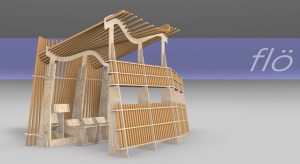
Better Bus Stop Design
Competition Finals
This Saturday May 4th
6 – 9 pm
Better Block Foundation HQ
700 West Davis
Look, Judge, Vote.
Downwinders at Risk is one of this year’s contest sponsors because it’s all about building a more people-friendly bus stop that’s also trying to minimize riders’ exposure to street level Particulate Matter pollution (PM.) Better Block was inspired to tackle this problem via its collaboration with Downwinders at Risk back in December on our Electric Glide Pub Crawl. This is a great example of how simply talking more about PM pollution can trigger a cascade of unintended beneficial effects.
Better Block gave 11 teams $250, four hours on their CNC router (basically, a giant printer for wood), and freedom to create whatever they want, as long as it’s a bus stop. Nine teams made 90 second videos on their designs you can see at the bottom of Better Block’s home page. They include a local couple, a Boston collective, Dallas’ own City Lab High School and UTA grads.
On Saturday those teams will actually build their prototypes at Better Block headquarters on West Davis. They’ll have judges determine a winner, but the public can also pick its favorite stop. Live Music and food trucks on site. Come and see the future while you wait for election returns.
Dallas Staff Attempts COG Coup on Air Monitoring Network
After being rebuffed by its own city council on the idea, Dallas Staff Goes to NCTCOG to promote autocratic regional air monitoring network
You may remember that way back last September members of the Dallas City Council Quality of Life Committee approved a independent regional air network as laid out in a 20 minute presentation by the University of Texas at Dallas’s Dr. David Lary and Downwinders’s Director Jim Schermbeck. They approved it 7-0 with even Rickey Callahan voting for it.
Usually when things get voted that favorably out of a Committee, they head straight to the full Council and get approved. But moments after the Committee vote City Staff demanded it not be sent to the full Council until December.
Everyone who knew the backstory of how much the Dallas Office of Environmental Quality and (Rockefeller) Sustainability hated the idea of such a network knew what was really going on. And sure enough, here it is April and there’s still no movement on the one regional network idea officially endorsed by a City Council Committee.
But guess what? Staff isn’t just standing still. No, they’re on the move. They’re not only going out of their way to shoot down the air monitoring network approved by members of their own the city council; they’re going out of their way to ignore the Dallas City Council all together and take their case for a more autocratic, less public network to the North Central Texas Council of Governments, or “COG.”
Not satisfied with allowing the worst environmental justice crisis since West Dallas to explode into Shingle Mountain during his watch, OEQ&(R)S’s James McQuire is now out to make sure Dallas residents never get a chance to make decisions about monitoring air quality in their own backyard.
Why? Because as one Dallas staffer put it, “too much participation by the public can be a bad thing.” McQuire and Company want a monitoring network staff can control without citizen participation or accountability, in other words the Status Quo. But of course the status quo has failed spectacularly to address both the region’s old, and new air pollution problems. UTD and Downwinders are proposing a model with heavy doses of public participation and representation.
So last month, McQuire submitted a request to COG to ignore what his own Dallas city council committee had endorsed, and instead start from scratch to build a less-democratic, more staff-driven network that would be run by the same agency that for years denied the Midlothian cement plants had any impact on DFW air quality. He did this OVER THE OBJECTIONS of Quality of Life Chair Sandy Greyson, who has a healthy skepticism of CO’s abilities to look out for Dallas’ interests.
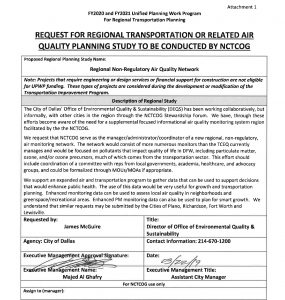 Like members of the Dallas Citizens Council who to make an end run around the City Council to get their own pet projects funded – see the VisitDallas headquarters slated for the new extension of Kyle Warren Park that is now being pimped by COG’s Director Michael Morris – McQuire is now circumventing his own Council and seeking relief from a “regional” agency that has historically only looked at air quality as an obstacle to highway funding.
Like members of the Dallas Citizens Council who to make an end run around the City Council to get their own pet projects funded – see the VisitDallas headquarters slated for the new extension of Kyle Warren Park that is now being pimped by COG’s Director Michael Morris – McQuire is now circumventing his own Council and seeking relief from a “regional” agency that has historically only looked at air quality as an obstacle to highway funding.
So let that soak in – Dallas city staff is intentionally ignoring its elected city council and the only air monitoring approach that council is on record as supporting, and instead now backing its own more autocratic version which has never been voted on by council and in fact was rejected out of hand by council members when asked.
It would take a novel’s worth of history to make the full case of why the COG is a poor choice for any new serious clean air effort in DFW but let’s start with just fundamentals.
COG has never cared about air quality from a public health perspective. Ever. Any work it’s done or is doing now – including promotion of electric vehicles and other anti-smog measures – are aimed at keeping DFW out of “non-attainment status” with the Clean Air Act in order to keep getting precious federal highway money. As long as the dollars keep flowing, COG isn’t interested in taking on other kinds of air pollution besides smog, or doing research into how even routine levels of combustion pollution are harmful, or until this moment, shown any interest in doing the air monitoring other metro areas are now routinely engaged in.
This skewed perspective is reflected in the language of McQuire’s proposal to COG. It’s all about how this air monitoring network could be a boon to transportation planning and oh by the way, maybe be of some public health interest too.
Because it lacks a public health perspective and is run by a cabal of local governments and staff by way of committees 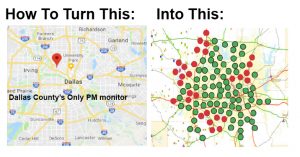 within committees, COG has been every bit as pro-active about bad air as the Dallas OEQ(R)S under McQuire, which is to say not a bit.
within committees, COG has been every bit as pro-active about bad air as the Dallas OEQ(R)S under McQuire, which is to say not a bit.
Downwinders spent years trying to convince COG leadership that three giant cement plants located in close proximity to each other in Midlothian, upwind of Dallas, and in eyesight of I-20 did in fact contribute to DFW smog. Despite spewing the equivalent of half a million cars worth of air pollution every year and being sited just across the Dallas and Tarrant county lines, the COG folks just didn’t get it – until Downwinders had to petition the EPA to bring those cement plants into DFW’s official smog plan itself. Those cement plants now have to be included in regional anti-smog plants but COG didn’t do that, citizens did.
When COG was writing its anti-smog plans, there were only two sides represented in it regional Clean Air Steering Committee: city staff and business. It took Downwinders to organize a collective boycott of this process until environmental groups were given seats at the table. COG didn’t do that, citizens did.
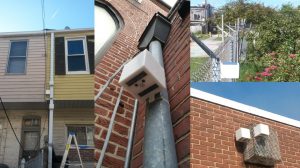 When fracking came to DFW, COG was as reluctant to point the finger at this huge source of new air pollution as it had been with the Midlothian cement plants. Why? Because local governments were benefactors of the Barnett Shale “boom” in tax revenues and drilling leases. COG steered clear from even acknowledging gas drilling as a significant air pollution problem and aligned with industry to dismiss concerns. It was up to local residents living next to drilling pads and compressor stations to write new rules for everything the drilling boom brought with it. Dallas residents wrote the most protective gas drilling rules in the state. COG didn’t do that, citizens did.
When fracking came to DFW, COG was as reluctant to point the finger at this huge source of new air pollution as it had been with the Midlothian cement plants. Why? Because local governments were benefactors of the Barnett Shale “boom” in tax revenues and drilling leases. COG steered clear from even acknowledging gas drilling as a significant air pollution problem and aligned with industry to dismiss concerns. It was up to local residents living next to drilling pads and compressor stations to write new rules for everything the drilling boom brought with it. Dallas residents wrote the most protective gas drilling rules in the state. COG didn’t do that, citizens did.
And if it had really been interested in air quality and air quality monitoring, the COG has had years to develop the idea and pursue it. It did not. Instead it was left up to non-profits like Downwinders and UTD to design and build a new approach to air monitoring. For over three years now this effort as been in the works and in fact James McQuire and his staff sat in on the meetings where the UTD model that was endorsed by his own council was drafted. He raised no objections at the time. Instead he waited until after the effort was finished and begin to sabotage it immediately from behind closed doors. Despite his best efforts at scuttling the proposal, the UTD model made it to Greyson’s committee and won a 7-0 vote. COG and Dallas OEQ(R)S didn’t do that. Citizens did.
And so now two of the region’s two most citizen-hostile entities are trying to team up and let COG do for Dallas air quality monitoring what it’s done to Dallas transportation policy – make it top heavy, unresponsive, undemocratic and staff controlled.
Like Greyson, Dallas County Commissioner Theresa Daniel is four-square against the COG idea and in favor of more public participation. Representing the largest local government entity involved, her opposition may keep McQuire’s effort from taking off despite his best bureaucratic efforts. And there’s also the May elections in Dallas to consider. A new council could have a lot more confidence in overriding staff proposals than the current one. And maybe that accounts for McQuire’s proposal arriving at COG now as well.
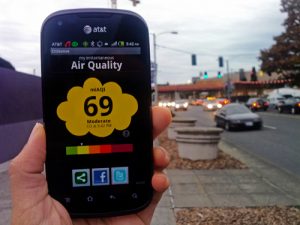
What really frustrating is that if McQuire and staff hadn’t begun his campaign to undermine the one approach that was favored by most of the entities involved, the Dallas city council would have already approved the UTD plan and we’d be on our way to building a truly independent monitoring network. Until Dallas staff objected last fall, there was a consensus about how to proceed. He’s single-handedly gutted that consensus, stifled all progress, and kept DFW way behind the air monitoring curve.
We’ll keep you up to date on how far this COG proposal gets, but Downwinders in Denton, Plano and Fort Worth should be on alert that McQuire is trying to get those cities on board with the COG approach as well. Please contact your most citizen-friendly council members and ask them not to support, what is in essence a staff coup in Dallas.
In the meantime, here’s one more question you can pose to Dallas council candidates this election season: “Do you support staff’s attempt to override the will of the council and impose a less public -friendly COG-run air monitoring network on Dallas, or the homegrown version proposed by UTD that’s already received a 7-0 vote?”
If this is going to get done right, citizens will have to do it.
Southern Sector Rising Went Eyeball to Eyeball with Dallas City Hall over Shingle Mountain. Dallas City Hall Blinked.
After a year of excuses, a determined group of women and their supporters shamed the City into finally taking action to close down the worst environmental health and justice crisis in Dallas.
When the collapse came, it came quickly.
Halfway through their Wednesday March 20th news conference giving authorities an ultimatum to shut down “Shingle Mountain” or face protests and possible civil disobedience, members of the freshly minted Southern Sector Rising Campaign for Environmental Justice learned the City of Dallas was reversing course and moving to close Blue Star’s year-old asphalt hell.
Only a week before, the official party line from City Hall was that the self-described “recycler” had all the permits it needed. Staff said critics’ description of Blue Star’s operation as an illegal dumping ground was wrong. It had “a right to be there.”
Now, on Wednesday….well, now circumstances had changed. The political circumstances that is.
Now there was a new coalition of frustrated Southern Dallas residents and Old School Icons like Peter Johnson, Luis Sepulveda and John Fullenwider staging an emotionally-charged news conference with chants of “Shame on Dallas” ringing loudly up and down the corridors of City Hall. Now there was a publicly-leaked report with incriminating evidence of official wrongdoing. Now there were swarms of cameras and reporters hanging on the every word of a middle-aged, middle-class, horse-loving DART employee who had been ignored for such a long time.
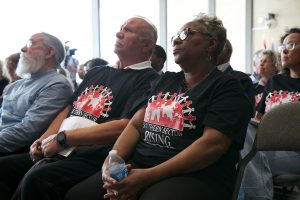
Three Generations of Dallas Environmental Justice Advocates: John Fullenwider, Luis Sepulveda and Marsha Jackson
Led by Marsha Jackson and her Choate Steet neighbors, Temeckia Durrough and Miriam Fields of the Joppa Freedman Town Association and Olinka Green from the Highland Hills Community Action Committee, with Stephanie Timko as media czarina, the Southern Sector Rising Campaign for Environmental Justice did more than just win a huge victory for an much-abused part of Dallas. It gave Southern Dallas residents a new model for effectively changing their circumstances.
An ad-hoc group that hadn’t even existed in February had the temerity to put City Hall on trial in its own lobby for Big D’s most spectacular municipal act of environmental racism in years. And it wasn’t even a fair fight.
An eye-opening state inspector’s report Downwinders sent to reporters a few days before the news conference officially documented permit violations and red flags too large to defend. Although Blue Star had promised the state in April 2018 it wouldn’t store more than 260 tons of waste at its site, it was already storing 60,000 tons in December. Blue Star was supposed to have a Fire Protection Plan. It didn’t. Blue Star was supposed to have adequate funds to close and clean up its site. It didn’t. Blue Star was supposed to randomly test incoming loads of shingles for asbestos. It didn’t.
This is how bad it was: Blue Star’s mocking of the law was too much even for Gregg Abbott’s Texas Commission on Environmental Quality. Or the City of Dallas.
So long before the last speaker spoke in the Flag Room, news came that the City had pulled the Certificate of Occupancy for the largest of the two Blue Star tracts, something it had previously said wasn’t possible. Then it announced it was taking the company to court the next day to get an emergency Temporary Restraining Order to close Blue Star down.
That City staff could so shamelessly pull off such a dramatic flip flop over a matter of a few hours is testimony to both the fury fueling the Campaign, and the overwhelming evidence that Blue Star and its government enablers had allowed a full-blown illegal dump to grow… and grow…and grow. The only thing missing from the turnaround was an apology and acknowledgement to the women that had forced City Hall’s hand.
In Thursday’s hearing on the Restraining Order, the City of Dallas cited a number of missing municipal and state permits it now said Blue Star needed, including a Special Use Permit, an air quality permit, and a permit for storage in the flood plain – none of which the City had demanded when Blue Star had opened for business a year earlier. Despite the lack of these permits the City was now saying were essential, it had kept telling reporters, Council Members, and residents alike that Blue Star was a legal business right up until the time of the news conference.
It wasn’t. Ever. But it took a group of frustrated Southern Dallas residents to expose that lie.
 Of course in the hearing itself the heretofore lack of official city concern about these lacking permits was perturbing in the extreme for the attorney representing Blue Star, who said City Hall had already signed-off on its operations.
Of course in the hearing itself the heretofore lack of official city concern about these lacking permits was perturbing in the extreme for the attorney representing Blue Star, who said City Hall had already signed-off on its operations.
“The City told my client there were NO air quality problems,“ he protested to the judge. That was undoubtedly a true statement. But that conclusion was rendered before a brigade of angry residents showed up at City Hall demanding Dallas enforce the law.
Now, presto-chango, the City was emerging out of its dilapidated telephone booth with its moldy Toxic Avenger costume on and finding plenty of air quality problems, albeit in a anecdotal, non-quantifiable, way.
Because despite being “very concerned” about air pollution from Blue Star, the City of Dallas never monitored air quality from the facility before it got to court. Neither did the state. Only Downwinders at Risk, plugging-in one of our own portable PM monitors on the top of Marsha Jackson’s window unit for days at a time, captured any credible scientific evidence of air pollution harms.
Those results were released at the March 20th news conference and showed levels of Particulate Matter pollution that UNT’s Dr. Tate Barrett concluded “poses a significant health risk to the residents.”
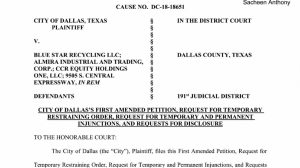
But in court, the City didn’t even mention those EPA-calibrated results.
For the first time in memory it was the regulators using only their senses to call for a crackdown – what they saw and heard and smelled at Blue Star’s site – and citizens showing up with Real Science.
Lacking any monitoring data of their own, Dallas city attorneys sounded like countless over-matched and overwhelmed residents from past TCEQ hearings, pleading with the judge to accept their word that the air pollution was so darn obvious…if not directly quantifiable because, well, no, we didn’t actually do any monitoring. We don’t know how to do that.
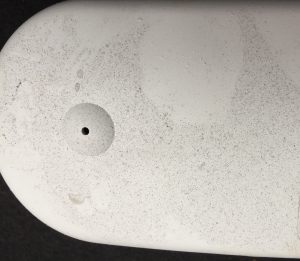
A layer of asphalt dust coated a Downwinders air quality monitor while it was recording levels of PM pollution at Marsha Jackson’s house in early March
This lack of any data to back up its air pollution claims was one of the most embarrassing parts of the hearing for the City. One wonders when James McQuire and his Office Of Environmental Quality & (Rockefeller) Sustainability’s stubborn refusal to buy its own air monitors will eventually cost the City (and its residents) in court.
But every time the City’s case looked in trouble, Blue Star’s attorney dug a deeper hole. He wanted the judge to know “shingles make really good fill” and that the spring-fed creek that ran through the company’s site was merely “a drainage ditch” and asking, after all judge, what is the true and right definition of “combustible” under Texas law?
Judge: “It means catch fire.”
Everyone but the Blue Star attorney chuckled.
After 45 minutes, Judge Gina Slaughter had heard enough and ruled in favor of the Restraining order. It took effect March 22nd and runs until Midnight on April 3rd.
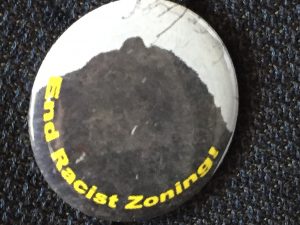 Before that happens, an 11 am Wednesday morning hearing will be held in the same courtroom to decide whether to extend the Temporary Order into a more permanent one. Word is that Blue Star was caught doing business during the last week when it wasn’t supposed to be on site at all. If true, it seems unlikely Blue Star will be granted a reprieve, despite the optimism displayed on the company’s website. “We fully expect to be open on Thursday April 4th, 2019″ it proclaims.
Before that happens, an 11 am Wednesday morning hearing will be held in the same courtroom to decide whether to extend the Temporary Order into a more permanent one. Word is that Blue Star was caught doing business during the last week when it wasn’t supposed to be on site at all. If true, it seems unlikely Blue Star will be granted a reprieve, despite the optimism displayed on the company’s website. “We fully expect to be open on Thursday April 4th, 2019″ it proclaims.
Not if Marsha Jackson, her friends in the Southern Sector Rising Campaign, and now their reluctant ally, The City of Dallas, get their way.


